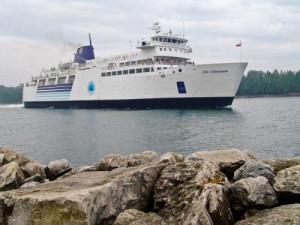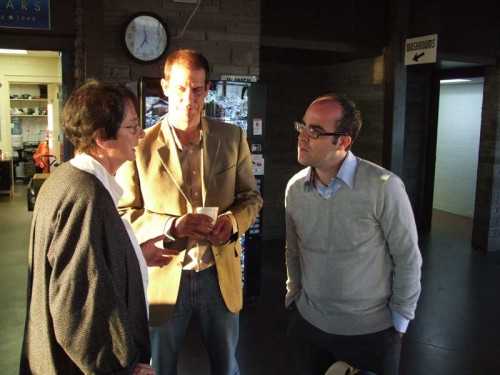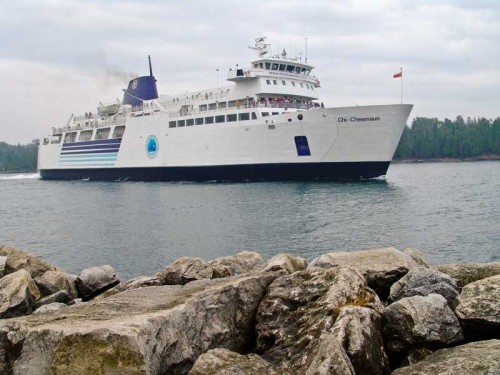SOUTH BAYMOUTH––The Owen Sound Transportation Company (OSTC) terminal in South Baymouth was packed last Wednesday evening September 26 as concerned Islanders came out to share their ideas with consultants hired by the OSTC to find answers as to why rider ship on the Chi-Cheemaun has plummeted 22 percent since 2005.
Jean-Francois Arsenault and Jean-Francois Pelletier, consultants with CPCS, a transportation consultancy firm formerly a part of CP Rail, posed questions on the state of the existing market and drivers, future market opportunities and market development strategy to a standing-room only crowd.
A second public meeting held at Tobermory the following day was similarly well attended.
Mr. Arsenault explained that the overarching objective of the project is to “identify the market that is currently not using the ferry services provided by the OSTC and determine what procedures are required in order to attract these potential passengers to the ferry.”
“We are not looking at everything about the ferry, just marketing,” he said. “So if the suggestion is ‘let’s have less kitchen staff,’ that is outside of our survey. We are not going there.”
The consultant sought to keep the discussion tightly focussed on those three key questions, and those questions were included in the relatively short notice advertisements announcing the meeting. But for a handful of comments quickly redirected, the meeting was generally kept well on track.
“At the end of the day we want to bring back to the OSTC actionable items (to improve ridership),” said Mr. Arsenault.
The consultants went through a brief history of the events leading up to their survey, including the precipitous drop in the numbers of passengers taking the ferry over the past decade and some of the changes in society and market trends that have taken place since 2005. The dollar change, global patterns in tourism and travel, gas prices and the ongoing project to increase Highway 17 to four lanes, were also named as being among those historical and current influences. But Mr. Arsenault cautioned that it is important to realize that some of the things that drove ferry use in the past “will not be coming back.”

In addition to surveys of rider patterns conducted a the beginning and end of August, and focus groups such as the gathering at the South Baymouth and Tobermory terminals, the consultants are studying other ferry systems across Canada and North America in search of best practices and clues as to what might work here.
The drop in ferry traffic cannot be directly linked to the current economic downturn, noted Mr. Arsenault, pointing out that the downward trend was already well established when the economy was booming, well before any impact of the 2008 global meltdown.
Some of the downturn has been worse in specific categories of traffic, particularly bus tours, which have tanked 60 percent since 2005.
The first order of business would most likely be to take steps to stabilize the market and stem any further decline, and then take action to improve the service to key market segments such as the community market, the bus market (which comprises about four percent of the current user base) and the freight industry. The consultants outlined three steps in dealing with the key questions they were seeking input on. Step one was a review of the existing market and drivers. Essentially, what are the ferry’s existing markets and what are the respective characteristics, needs, trands, drivers and outlook for those markets? Who are the ferry’s main competitors? Essentially doing a SWOT analysis (strengths, weaknesses, opportunities and threats).
Step two will review future market opportunities. What potential is there for future growth from existing markets and what conditions would foster such growth? In this step the consultants will seek answers to how untapped markets are currently being served and how much of an opportunity exists in such markets and why it is those markets are currently untapped-if tapped into by the OSTC marketing would they result in increased traffic for the ferry?
Step three will be aimed at what growth in traffic could be anticipated in the short, medium and long-term. What strategies would be effective in “realized identified opportunities,” and of course, what resources would be required to implement those strategies.
Mr. Arsenault noted that the objective of the public meeting was to “obtain comments, remarks and suggestions in relation to six subset questions. What factors may have contributed to the decrease in traffic? Does the ferry adequately support tourism in the region? What markets, currently served or not, could be better served by the ferry? What potential actions or changes could improve the ferry service to better serve these markets and increase ridership?” And finally, did the audience have any other comments remarks or suggestions that could help the consultants “define a better way forward for the ferry.”
The consultants expect the first report outlining the context and methods of their study to be available by the end of October; the second phase before Christmas and the final wrap up should be available by February. The plan is to update information on the website, www.chicheemaunmarketstudy.com, as each report becomes available.
The consultants assured those attending the meeting that their company had no vested interest or intent other than wanting the project to succeed in finding ways to increase ferry traffic. “We want this to work,” said Mr. Arsenault. “That is our intent.”
The consultants said that they hope to be identifying the “low hanging fruit” actionable items that can be implemented as early as next season.
The first suggestion out of the gate was a theme that was to be voiced a number of times throughout the evening and hinted at the reason for the meeting’s high turnout.
“I would like to hear that you plan to take care of the base you have,” said a gentleman who noted that he spends part of his year on Manitoulin and part in his native United States.
Mr. Arsenault was quick to agree. “The first step in stopping the decline in demand is in keeping your existing customer base,” he said. “Annoying your current customers is not a good base from which to grow.”
The second main theme identified repeatedly through the meeting was the need to increase market visibility of the ferry in key markets, including southern Ontario, Toronto and the US.
“When I am in Toronto there is nothing I can read about here,” said one woman who identified herself as a long time summer resident of Manitoulin and winter denizen of Toronto. “There are hundreds of ways of doing it. There has to be a way of reaching people who are looking for a special place.”
The Manitoulin Publishing tourism publication “Manitoulin Magazine” was referenced by a number of people during the meeting as an outstanding resource for visitors, containing a useful map and many articles on things to do and see.
One of those extolling the publication’s virtues was Paul Bowerman, an OSTC employee who was happy to take advantage of the opportunity to have input into the project. Mr. Bowerman read from a list of comments and suggestions he had collated from those comments made to him by ferry users.
“A lot of people are disappointed in the $15 additional charge for reservations,” he said. “People feel they are being taken advantage of.”
The reservation system was definitely an early target of those in attendance-with the emphasis on the need to check in with a reservation an hour before the sailing, and most particularly the additional fee on some sailings.
Another issue was the perceived preferential treatment given to motorcycles in boarding. “They send the motorcycles up first even though there might be some people there who have been waiting for an hour and a half,” said Mr. Bowerman.
The practice of charging for each travellor in a vehicle was also decried, with suggestions that charging by the foot for the length of vehicles would be better received and perceived as fair.
The loss of the priority pass and frequent rider programs was also a sore point. Some in the meeting identified themselves as traveling as much as 21 times a season on the ferry, but that their loyalty to the transportation venue was not honoured, recognized or appreciated.
The strict adherence to the one-hour appearance for reservations came under fire. “If you are one minute late, you lose your spot,” noted one person to murmers of general agreement. “Can the reservation system!” shouted one commentator.
Rick McCutcheon, publisher of The Manitoulin Expositor, Manitoulin Magazine and This is Manitoulin, was attending the meeting as a long-time member of the Manitoulin Tourism Association and recalled that the reservation system was lobbied for heavily by regular users of the ferry and resisted by the ferry’s operators for a number of years before being implemented.
Suggested modifications to the reservation system included making it free, only reserving one third of the vessel on each passage and making it entirely first-come first-served. Deducting the fee from the fare of those who arrive on time was another suggested option, as was allowing a 24-hour no cost cancellation policy. “A reservation fee is one thing,” said one woman, referencing other travel services. “If you are calling within 24 hours you are stuck with it, like it or leave it.”
The lack of signage for the ferry was also presented as a possible cause of dropping ridership. “There is not one sign in Little Current,” said one audience member. “If they miss the turnoff they wind up in Gore Bay. You can bet when that happens to someone they will never come back.”
As continuing portion of the signage debate, it was suggested that having an LED highway sign indicating how fully the next sailing was booked would be an invaluable resource for travellers. “I am much more likely to head down Highway 6 to catch the ferry from Highway 17 if I know the ferry is only 75 percent full,” agreed another audience member.
The high cost of the ferry service was cited by quite a number of people, with some offering up alternatives regimes, including the late-lamented frequent traveller discounts, reduced fees for round trips.
Alain Harvey of Providence Bay’s Auberge Inn, an accommodation business specializing in the hostel travel market, noted that communication on the reservation fee be improved so that people are aware of the policies surrounding it. “Put it up there in big red letters,” he said.
The removal of telephone booths and the lack of cell service have a depressive effect as well, noted another respondent. The inability to contact accommodation on the Island, or let a friend or relative know that the ferry will be late coming into port was a concern for a number of people. OSTC employees have been instructed not to allow the terminal telephones to be used for anything other than OSTC business.
Other suggested concepts include more cooperative advertising on the Internet, including YouTube videos, working together with local tourism operators to make the ferry more of an experiential option, as well as reaching out to the Asian and other ethnic markets in Toronto. Linking more of the events and attractions on Manitoulin Island on the Chi-Cheemaun webpage and bringing back discount programs with resorts and attractions were suggested by a number of operators, including Rita Gordon of Tehkummah’s Gordon’s Park and Maja Mielonen of Mindemoya, an attraction operator and bicycle activist.
“It would energize us to get our guests to use the ferry,” suggested Ms. Gordon. When the previous discount program ran, “many of us had put it on our brochures.”
Ms. Mielonen also suggested that the ferry should make a concerted effort to reach out to the burgeoning cycling tour market and include the major Island events, such as Haweater Weekend, the Wikwemikong Cultural Festival, powwows and Country Fest.
Craig and KT Timmermans, radio station operators and promoters of Country Fest, noted that they had tried for a number of years to engage the OSTC in advertising on 100.7 FM but gained little traction despite offering “a very attractive rate.”
Ms. Timmermans noted that she travels south a number to Toronto several times a year, but has only once taken the ferry. “It’s the cost,” she said. “Let the driver go with the car.”
Others cited the relatively equal travelling time to reach destinations in southern Ontario.
Another suggestion was to have an ‘open house’ reception on the ferry to bring together the business communities of Manitoulin and Tobermory.
Parking issues were also brought up, specifically the lack of sufficient parking. Another local businessperson noted that she had cleared a parking space and attempted to interest the OSTC for two years into leasing the parking space to no avail.
There were suggestions to move the kitchen to a private operator, offering more and healthier meal options, and placing more student guides on the ferry to talk about local history and attractions.
Linda Belton of Mindemoya pointed out that parents driving with children might be attracted to the opportunity to break up the long car ride north. Another audience member noted that his four adult children each have two children of their own and the ferry is simply too expensive for them to utilize when coming to visit.
A number of audience members criticized the management of the OSTC (not front line employees) repeatedly through the meeting, prompting Mr. McCutcheon to speak up, noting the OSTC has a very limited management complement and that the pressure on the ferry operator to keep costs to government tightly reined in was likely intense. “The government does not want to pay out one cent more than they have to,” he suggested. “The politicians have to be convinced that the ferry is a good thing to invest in.”
A number of audience members referenced that many southern Ontario regions have subsidized public transit. “If they can subsidize southern Ontario transportation the North should be getting its share,” said one audience member, to a murmur of agreement throughout the crowd.
Ken Ferguson of Sheguiandah suggested that should changes be made, the currently scheduled trips should continue as many people have “the schedule burned into their brains.”
Another suggestion from someone who identified themself as someone who has travelled extensively, was to board people right away and take their money afterward. “Right now you sell a ticket to get on,” he said. “Sell a ticket to get off.” That would cut down boarding times and allow a less onerous arrival time for reservations he suggested.
One of the most hopeful bits of information to come out of the meeting was that traffic seems to have risen slightly this year. “Right at this point in time we are about two percent up,” said terminal manager John Cranston.
The same meeting played out in Tobermory the following evening, with largely the same script, although with about half the attendance. “There were probably about 45 people at the peak,” said Mr. Arsenault. “The meeting lasted about two hours as well.”
The reservation system, and its cost, was also a big source of concern for those at the meeting. There was also a fair bit of management bashing from folks in the seats. “There were no obvious differences,” he said.
One difference noted by those attending had to do with markets. “The customers on this side of the ferry tend to be a more mixed ethnicity,” said Mr. Arsenault. “Whereas the people taking the ferry tended to be described as ‘white and older.’
There was some criticism of the Manitoulin side of the ferry for not providing a reason to take the Chi-Cheemaun across-a perceived lack of tourist attractions.
The Tobermory side tends to cater heavily to the ethnic and younger markets, with brochures outlining day trip opportunities and often those brochures are written in ethnic languages.
There was a lot more focus on the ferry website on the Tobermory side as well. “While on the South Baymouth side the focus was on cross marketing and cooperative approaches with the community, the Tobermory side concentrated more on mistakes on the site, confusing or incorrect information,” noted Mr. Arsenault.
Mr. Arsenault said that the notes on the meetings should be up on the website by publication date (Wednesday).





